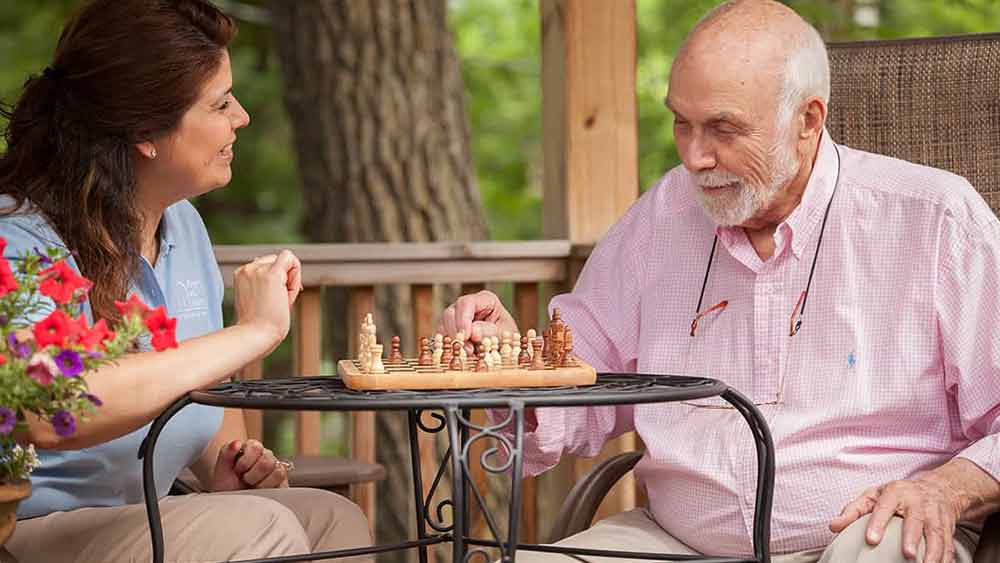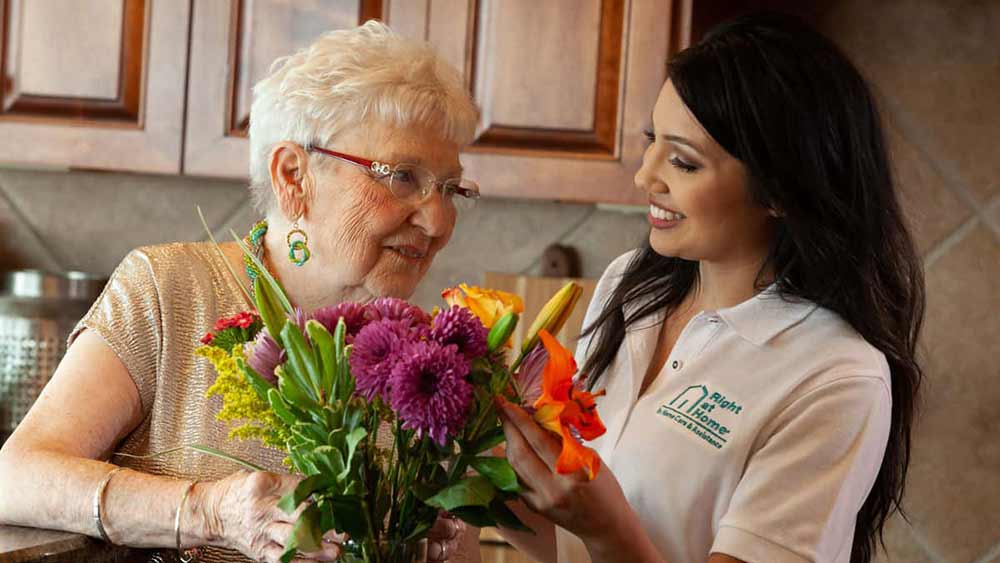

Improving Communication With Someone With Dementia
As a gerontologist working for nearly 30 years in health promotion/administration and Alzheimer’s disease, Dr. Diane Darby Beach specializes in trainings on dementia care for families and care professionals. Dr. Beach has a master’s degree in public health and a doctorate in education and is a spokesperson for the Right at Home Cognitive Support Program. Below, Dr. Beach provides answers to questions about communicating with a person who has dementia, to benefit family and professional caregivers.
How does dementia affect communication pathways in the brain?
Especially with Alzheimer’s-type dementia, the plaques and tangles in the brain affect a person’s judgment and reasoning. The person with dementia struggles to reason clearly and they have a lapse in judgment. They might give money away or dress for a Minnesota snowstorm when it’s 80 degrees. These behaviors create communication dilemmas; many times, it’s because the short-term memory is failing while the long-term memory is intact. As caregivers, we have to remember that.
A person with dementia can also become “aphasic,” meaning their verbal communication is completely gone. Patients who have had a stroke or who have dementia and are aphasic may get some of their verbal communication back with rehabilitation, but with Alzheimer’s dementia, the most common form of dementia, once verbal communication is gone, it’s gone. The important thing to remember is that even though the loved one’s verbal communication is absent, their nonverbal communication improves.
How do dementia behaviors alter interpersonal communication?
When people with dementia express repetitive questioning, or they shadow you or show combative behavior, that’s how they’re communicating with you, because they don’t have the words anymore. Their language comes out in behaviors. When we learn how to manage the behaviors of a person with dementia, then we can redirect the behaviors, much like we would a three-year-old, and get the person focused on something else. And the heart of this is the ability to validate and redirect patients with dementia through communication. To do this effectively, you have to know the person with dementia.
Family caregivers need to know what their loved one likes and dislikes. What did the person with dementia do for a living? What makes them happy? What were their hobbies? You can use all of this information to validate the person and redirect their behavior. Professional staff in home care or in an assisted living environment can be trained on how to obtain an accurate social/emotional history. It is vital to get a medical history, but also vital to figure out the social/emotional background to learn how to validate and redirect the patient with dementia.
For example, I had a client with dementia who was a retired elementary schoolteacher and lived at home with her daughter. Every day, this former teacher would get agitated in the morning because she would collect papers around her. In her mind, she thought she was getting ready for school. Her daughter, bless her heart, was trying to talk her mother out of her morning school preparation. “Mom, you’re no longer a schoolteacher,” she would say. “You retired 20 years ago.”
But that was about the worst thing the daughter could do, because the daughter just invalidated her mom, and her mom was thinking, “What do you mean, I’m not a schoolteacher?” The mom would get more agitated, and then it was a vicious cycle. To handle this situation, we hone in on the person with dementia’s sense of purpose. Teaching was this mother’s sense of purpose for many years. When we validate and redirect the loved one, we may need to tell a little white lie, which I call “therapeutic fibbing.” You could say, “Mom, you are a teacher,” not, “You were a teacher,” because in the mother’s current moment, she is a schoolteacher. You could say, “Mom, you are a phenomenal teacher, and your kids love you, but you know what? It’s Saturday; there’s no school today. Let’s get breakfast.”
In a home care or facility situation, Right at Home uses person-centered care to talk to family members to get the loved one’s full history, particularly their social/emotional history, to put into their care plan. This is not a cookie-cutter approach. The way I communicate with client Alice is probably going to be different than the way I communicate with client Bob. It’s all about knowing the person and individualizing the messages to the occasion and the care.
How does this person-centered care play out in day-to-day interactions?
Validate, redirect, and then go slowly with somebody with dementia. Because the more you rush somebody with dementia, the more they get agitated. If the caregiver gets upset, then the person with dementia is like a sponge; they pick up on that and express more behaviors. And now you’re in trouble, because it’s 10 times harder to get out of the behavior cycle than it is to prevent it in the first place. A person with dementia can handle one or two steps at a time—two maximum. If a daughter with a mother who has dementia greets Mom in the morning by saying, “Mom, we’re going to have breakfast, then we’re going to take a shower, then we’ll get dressed, and then I’ll take you to your doctor,” you’ve lost her at “breakfast.”
What are some steps to improve communication with people with dementia?
You need thorough documentation and a social/emotional history on the individual. For example, if a Right at Home caregiver walks into a new client’s house and the client, who has dementia, has never had breakfast before 10 a.m. and the caregiver tries to get the client to eat at 8:30 a.m., the caregiver will have a problem. You need the social/emotional history and personal data to validate and redirect.
A few other communication tips include the following:
Use short, simple sentences. Talk slowly. When a caregiver walks into a home to take care of somebody with dementia, whatever energy the caregiver brings, the person with dementia is going to pick up on it. For example, if I’ve just had an argument with my husband and haven’t quite cleared myself of that and I go in to take care of Sally, she’s going to pick up on that energy quick—that’s the client with dementia’s nonverbal intuitiveness. If you’re sad, if you’re happy, if you’re anxious, they will know.
Use eye contact. When you look at anyone, you’re telling that person you care about them, that they are a priority, and that you’re listening. I tell home caregivers all the time, when you go to a client with dementia’s home, the person may not have any words, so engage them in eye contact and listen for feelings. The more you get to know the person, the more you know when they’re anxious or sad, and then you can put words to their feelings even when they don’t have words.
Be proactive with communication. Let’s say your loved one with dementia slips into what is called “sundowning,” when they have confusion or agitated behaviors in late afternoon or early evening. It is difficult when the behavior occurs to try to talk the person with dementia into doing something else or validate and redirect them. Instead, if you know the person experiences sundowning at 4:30 p.m. or so every day and you’re just waiting for the behavior to happen, you can become proactive and engage the person in an activity ahead of time. Take them for a walk or do an art project. As a family member or professional caregiver, choose to be proactive rather than reactive and waiting for the sundowning to occur.
Focus on what the person can still do, rather than on what they can’t do. That’s a communication strategy in terms of modifying the activities for the person with dementia. Let’s say our client was always a good cook, but now she can’t process all the steps in a recipe. But if you cut up or measure all the ingredients, maybe she can still put the ingredients in the skillet or bowl and stir them. As the dementia progresses and the client becomes bedbound, you may be able to take her in a wheelchair to the kitchen and let her smell the ingredients. That’s still activating her senses, which is good for her brain, and she’s still getting some enjoyment out of that.
What advice do you have for family caregivers of loved ones with dementia?
Practice self-care. The most important thing is your own self-care. It sounds counterintuitive, because if you’re a family caregiver, you’re a giver, and you tend to put your loved one first. But if you don’t take care of yourself, I guarantee you, you’re not going to be well enough or even around to take care of your loved one with dementia. So stay in touch with your friends, go out for coffee, keep up with your exercise program, eat well, and try to sleep well.
Pace yourself. There are a lot of family members, especially spouses, who’ll say, “No, no, no. I’ve got this.” No, you do not have this. If you go at a pace that’s so fast, thinking you’re only running a couple of miles, and then you get one mile into dementia care and realize that this is a marathon and you’ve got 25+ miles to go, you’re going to burn out.
Recognize that you are not alone. Don’t let yourself get isolated. Ask for help and accept help when it’s offered. Call Right at Home, which can send resources and “A Guide for Those Supporting Loved Ones With Dementia or Cognitive Change,” or set you up with home care or respite care. Call the Alzheimer’s Association. Support groups are available. Talk with other people who are in the same boat, so you won’t feel so alone. Practice self-care, pace yourself and know you’re not alone. And please don’t be afraid to ask for help. We are all here for you.







